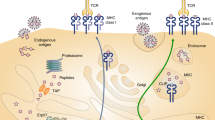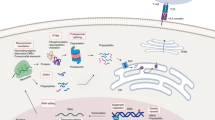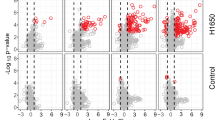Abstract
Early diagnosis of cancer is crucial for successful treatment. Noninvasive assays for detecting tumor-derived antigens in serum and other bodily fluids have the potential to screen healthy individuals for hitherto undetected cancers. Very few such assays have been successfully developed, in part because identifying potential target antigens remains a challenge. To identify new blood-borne tumor antigens for the purpose of establishing such assays, we have developed a novel technique called differential immunization. Using this method, we have identified PHB1 and PHB2, proteins thought to function as mitochondrial chaperones and transcriptional regulators, as antigens released from colorectal tumors in vivo. Serum from colorectal patients contains significantly higher levels of these antigens compared to serum from healthy volunteers. These data demonstrate that differential immunization is an effective new method for identifying tumor-derived antigens in serum.
This is a preview of subscription content, access via your institution
Access options
Subscribe to this journal
Receive 50 print issues and online access
$259.00 per year
only $5.18 per issue
Buy this article
- Purchase on Springer Link
- Instant access to full article PDF
Prices may be subject to local taxes which are calculated during checkout




Similar content being viewed by others
References
Anandatheerthavarada HK, Biswas G, Mullick J, Sepuri NB, Otvos L, Pain D and Avadhani NG . (1999). EMBO J., 18, 5494–5504.
Ardekani AM, Liotta LA and Petricoin III EF . (2002). Expert Rev. Mol. Diagn., 2, 312–320.
Bacher S, Achatz G, Schmitz ML and Lamers MC . (2002). Biochimie, 84, 1205–1218.
Bangma CH and Verhagen PC . (2000). Microsc. Res. Tech., 51, 430–435.
Bast Jr RC, Ravdin P, Hayes DF, Bates S, Fritsche Jr H, Jessup JM, Kemeny N, Locker GY, Mennel RG and Somerfield MR . (2001). J. Clin. Oncol., 19, 1865–1878.
Berger KH and Yaffe MP . (1998). Mol. Cell. Biol., 18, 4043–4052.
Bhagwat SV, Biswas G, Anandatheerthavarada HK, Addya S, Pandak W and Avadhani NG . (1999). J. Biol. Chem., 274, 24014–24022.
Bok RA and Small EJ . (2002). Nat. Rev. Cancer, 2, 918–926.
Coates PJ, Nenutil R, McGregor A, Picksley SM, Crouch DH, Hall PA and Wright EG . (2001). Exp. Cell Res., 265, 262–273.
Dexter DL, Barbosa JA and Calabresi P . (1979). Cancer Res., 39, 1020–1025.
Fusaro G, Wang S and Chellappan S . (2002). Oncogene, 21, 4539–4548.
Harlow E and Lane D . (1998). Antibodies: A Laboratory Manual. Cold Spring Harbor Press: Cold Spring Harbor.
Huang LJ, Wang L, Ma Y, Durick K, Perkins G, Deerinck TJ, Ellisman MH and Taylor SS . (1999). J. Cell Biol., 145, 951–959.
Liu XT, Stewart CA, King RL, Danner DA, Dell'Orco RT and McClung JK . (1994). Biochem. Biophys. Res. Commun., 201, 409–414.
Maggino T and Gadducci A . (2000). Eur. J. Gynaecol. Oncol., 21, 64–69.
Molina R, Jo J, Filella X, Zanon G, Pahisa J, Munoz M, Farrus B, Latre ML, Gimenez N, Hage M, Estape J and Ballesta AM . (1996). Anticancer Res., 16, 2295–2300.
Montano MM, Ekena K, Delage-Mourroux R, Chang W, Martini P and Katzenellenbogen BS . (1999). Proc. Natl. Acad. Sci. USA, 96, 6947–6952.
Niebuhr K, Lingnau A, Frank R and Wehland J . (1998). Cell Biology: A Laboratory Handbook, Vol. 2. In: Celis J (ed) Academic Press: San Diego, pp. 398–403.
Nijtmans LG, Artal SM, Grivell LA and Coates PJ . (2002). Cell Mol. Life Sci., 59, 143–155.
Nijtmans LG, de Jong L, Artal Sanz M, Coates PJ, Berden JA, Back JW, Muijsers AO, van der Spek H and Grivell LA . (2000). EMBO J., 19, 2444–2451.
Piper PW and Bringloe D . (2002). Mech. Ageing Dev., 123, 287–295.
Sleeman JP . (1993). Oncogene, 8, 1931–1941.
Sleeman JP, Kim U, LePendu J, Howells N, Coquerelle T, Ponta H and Herrlich P . (1999). Oncogene, 18, 4485–4494.
Terashima M, Kim KM, Adachi T, Nielsen PJ, Reth M, Kohler G and Lamers MC . (1994). EMBO J., 13, 3782–3792.
Towbin H, Staehelin T and Gordon J . (1979). Proc. Natl. Acad. Sci. USA, 76, 4350–4354.
Wang S, Fusaro G, Padmanabhan J and Chellappan SP . (2002a). Oncogene, 21, 8388–8396.
Wang S, Nath N, Adlam M and Chellappan S . (1999a). Oncogene, 18, 3501–3510.
Wang S, Nath N, Fusaro G and Chellappan S . (1999b). Mol. Cell Biol., 19, 7447–7460.
Wang S, Zhang B and Faller DV . (2002b). EMBO J., 21, 3019–3028.
Acknowledgements
We are very grateful to Norma Howells and Selma Huber for excellent assistance with animal experiments, and to Phil Coates for helpful discussions. This work was supported by a grant to JPS by the Association for International Cancer Research (AICR).
Author information
Authors and Affiliations
Corresponding author
Rights and permissions
About this article
Cite this article
Mengwasser, J., Piau, A., Schlag, P. et al. Differential immunization identifies PHB1/PHB2 as blood-borne tumor antigens. Oncogene 23, 7430–7435 (2004). https://doi.org/10.1038/sj.onc.1207987
Received:
Revised:
Accepted:
Published:
Issue Date:
DOI: https://doi.org/10.1038/sj.onc.1207987
Keywords
This article is cited by
-
A novel prognostic marker and immunogenic membrane antigen: prohibitin (PHB) in pancreatic cancer
Clinical and Translational Gastroenterology (2018)
-
Recent insights into the actions of IGFBP-6
Journal of Cell Communication and Signaling (2015)
-
Follicular stage-dependent regulation of apoptosis and steroidogenesis by prohibitin in rat granulosa cells
Journal of Ovarian Research (2013)
-
The immediate early gene Ier2 promotes tumor cell motility and metastasis, and predicts poor survival of colorectal cancer patients
Oncogene (2012)
-
Prohibitin is overexpressed in Huh-7-HCV and Huh-7.5-HCV cells harboring in vitro transcribed full-length hepatitis C virus RNA
Virology Journal (2011)



